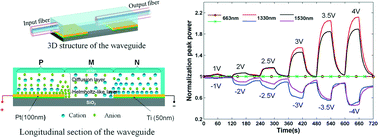Electro-optical phenomena based on ionic liquids in an optofluidic waveguide†
Abstract
An optofluidic waveguide with a simple two-terminal electrode geometry, when filled with an ionic liquid (IL), forms a lateral electric double-layer capacitor under a direct current (DC) electric field, which allows the realization of an extremely high carrier density in the vicinity of the electrode surface and terminals to modulate optical transmission at room temperature under low voltage operation (0 to 4 V). The unique electro-optical phenomenon of ILs was investigated at three wavelengths (663, 1330 and 1530 nm) using two waveguide geometries. Strong electro-optical modulations with different efficiencies were observed at the two near-infrared (NIR) wavelengths, while no detectable modulation was observed at 663 nm. The first waveguide geometry was used to investigate the position-dependent modulation along the waveguide; the strongest modulation was observed in the vicinity of the electrode terminal. The modulation phase is associated with the applied voltage polarity, which increases in the vicinity of the negative electrode and decreases at the positive electrode. The second waveguide geometry was used to improve the modulation efficiency. Meanwhile, the electro-optical modulations of seven ILs were compared at an applied voltage ranging from ±2 V to ±3.5 V. The results reveal that the modulation amplitude and response speed increase with increasing applied voltage, as well as the electrical conductivity of ILs. Despite the fact that the response speed isn't fast due to the high ionic density of ILs, the modulation amplitude can reach up to 6.0 dB when a higher voltage (U = ±3.5 V) is applied for the IL [Emim][BF4]. Finally, the physical explanation of the phenomenon was discussed. The effect of the change in IL structure on the electro-optical phenomena was investigated in another new experiment. The results reveal that the electro-optical phenomenon is probably caused mainly by the change in carrier concentration (ion redistribution near charged electrodes), which induces the enhancement and suppression of NIR optical absorption (contributed by C–H and N–H groups) in the vicinity of the negative electrode and positive electrode, respectively.


 Please wait while we load your content...
Please wait while we load your content...